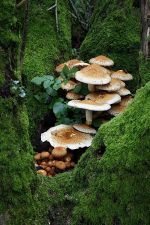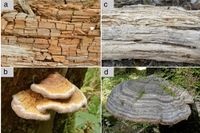Saprotrophic nutrition: Difference between revisions
No edit summary |
No edit summary |
||
| Line 1: | Line 1: | ||
[[File:Saprobes.jpg|150px|thumb|right|Some Shaggy Pholiota growing on trees, these fungi are wood-rotting saprobes]]'''Saprotrophic nutrition''' is an example of [[extracellular digestion]] of decayed organic matter by organisms such as fungi and [[soil bacteria]]. Saprotrophic microscopic fungi are often called '''saprobes'''; saprotrophic plants or bacterial flora are called '''saprophytes'''. The process is most often facilitated by active transport of such materials through endocytosis within the internal mycelium and its constituent hyphae. Fungi, bread mould, some protists, and many bacteria are saprophytic in nutrition. | [[File:Saprobes.jpg|150px|thumb|right|Some Shaggy Pholiota growing on trees, these fungi are wood-rotting saprobes]]'''Saprotrophic nutrition''' is an example of [[extracellular digestion]] of decayed organic matter by organisms such as fungi and [[soil bacteria]]. Saprotrophic microscopic fungi are often called '''saprobes'''; saprotrophic plants or bacterial flora are called '''saprophytes'''. The process is most often facilitated by active transport of such materials through endocytosis within the internal mycelium and its constituent hyphae. Fungi, bread mould, some protists, and many bacteria are saprophytic in nutrition. Saprobes often use their hyphae to penetrate wood and other solid materials. Saprotrophic bacteria are more adept at breaking down fluid and semi-fluid materials [2]. | ||
==Process== | ==Process== | ||
| Line 9: | Line 9: | ||
===Conditions=== | ===Conditions=== | ||
Optimal growth and repair of saprophytic organisms requires favorable conditions [1]. | |||
*'''Presence of water''': 80–90% of the body of a fungi is comprised of water by mass. Fungi require excess water in their environment for intake due to the evaporation of internally retained water. | |||
*'''Presence of oxygen''': Anaerobic conditions do not allow for the optimal growth of saprophytic organisms above media such as soil and water. | |||
*'''Neutral pH''': pH levels around 7 are required. | |||
*'''Moderate temperatures''': Optimal growth of saprotrophic organisms occurs at 25°C, most of these organisms can grow and thrive between the temperatures of 1°C and 35°C. | |||
==Occurrence in Nature== | |||
[[File:WhitevBrownRot.jpg|thumb|200px|right|Brown and white rot residues and fungal fruit bodies. a) Brown rot residue, b) brown rot fungus, Fomitopsis pinicola, c) white rot residue, d) white rot fungus, Fomes fomentarius]] | |||
===Materials Colonized by Saprotrophic Organisms [2]=== | |||
====Wood==== | |||
Fungi are the fundamental decomposers of wood. Without the ecosystem services provided by fungi as wood decomposers, our forests would be filled with wood piles. There are two physiological types of wood-decay fungi recognized by those who work in the field: those that produce brown rots and those that produce white rots. These two physiological categories reflect the composition of the wood and the processes by which the fungi decompose the wood. Glucose stored in the wood is a vital nutrient for fungi that is sometimes difficult to obtain due to its binding in cellulose and lignin. Those fungi that digest the cellulose within the lignin matrix leave behind a mass of brown lignin. Those fungi that cause white rot dissolve the lignin first and leave behind the white fibrous cellulose for later digestion. The most efficient wood-decay fungi are members of the [[Basidiomycota]] and can be seen on decaying logs, stumps, and trees. | |||
====Fallen Leaves/Leaf Litter==== | |||
====Wrack==== | |||
====Dung==== | |||
==Nutrient Cycling== | |||
==References== | |||
1. Clegg & Mackean (2006, p. 296), fig 14.17—A diagram explaining the optimal conditions needed for successful growth and repair | |||
2. D. Malloch, ''Natural History of Fungi'', (A part of the Mycology Web Pages, New Brunswick Museum. [http://website.nbm-mnb.ca/mycologywebpages/NaturalHistoryOfFungi/Saprotrophs.html] 2017) | |||
3. | |||
4. | |||
Revision as of 11:49, 29 April 2019

Saprotrophic nutrition is an example of extracellular digestion of decayed organic matter by organisms such as fungi and soil bacteria. Saprotrophic microscopic fungi are often called saprobes; saprotrophic plants or bacterial flora are called saprophytes. The process is most often facilitated by active transport of such materials through endocytosis within the internal mycelium and its constituent hyphae. Fungi, bread mould, some protists, and many bacteria are saprophytic in nutrition. Saprobes often use their hyphae to penetrate wood and other solid materials. Saprotrophic bacteria are more adept at breaking down fluid and semi-fluid materials [2].
Process
In the presence of decaying organic matter, saprophytes and saprobes release digestive enzymes in their surrounding medium to convert complex organic molecules down to their simpler constituents. This simpler food is then absorbed through the body surface and utilized for various metabolic activities in the saprophyte. An example of this is the breakdown of starch into glucose or sucrose.
- Proteins are broken down into their amino acid components via the breaking of peptide bonds
- Lipids are broken down into fatty acids and glycerol
- Starch is broken down into simpler sugars
Conditions
Optimal growth and repair of saprophytic organisms requires favorable conditions [1].
- Presence of water: 80–90% of the body of a fungi is comprised of water by mass. Fungi require excess water in their environment for intake due to the evaporation of internally retained water.
- Presence of oxygen: Anaerobic conditions do not allow for the optimal growth of saprophytic organisms above media such as soil and water.
- Neutral pH: pH levels around 7 are required.
- Moderate temperatures: Optimal growth of saprotrophic organisms occurs at 25°C, most of these organisms can grow and thrive between the temperatures of 1°C and 35°C.
Occurrence in Nature

Materials Colonized by Saprotrophic Organisms [2]
Wood
Fungi are the fundamental decomposers of wood. Without the ecosystem services provided by fungi as wood decomposers, our forests would be filled with wood piles. There are two physiological types of wood-decay fungi recognized by those who work in the field: those that produce brown rots and those that produce white rots. These two physiological categories reflect the composition of the wood and the processes by which the fungi decompose the wood. Glucose stored in the wood is a vital nutrient for fungi that is sometimes difficult to obtain due to its binding in cellulose and lignin. Those fungi that digest the cellulose within the lignin matrix leave behind a mass of brown lignin. Those fungi that cause white rot dissolve the lignin first and leave behind the white fibrous cellulose for later digestion. The most efficient wood-decay fungi are members of the Basidiomycota and can be seen on decaying logs, stumps, and trees.
Fallen Leaves/Leaf Litter
Wrack
Dung
Nutrient Cycling
References
1. Clegg & Mackean (2006, p. 296), fig 14.17—A diagram explaining the optimal conditions needed for successful growth and repair
2. D. Malloch, Natural History of Fungi, (A part of the Mycology Web Pages, New Brunswick Museum. [1] 2017)
3.
4.